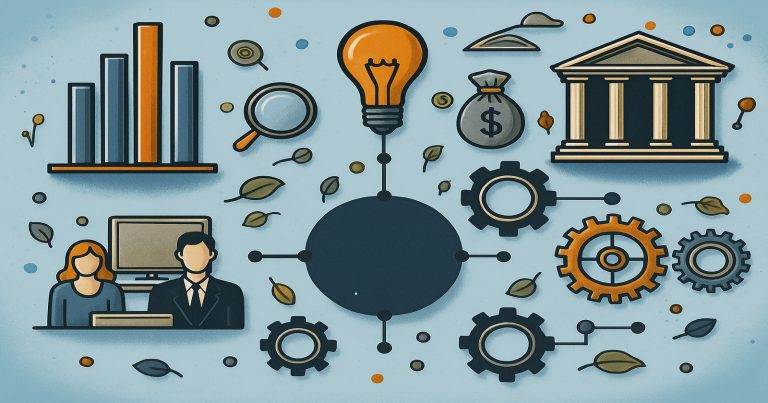The business environment comprises internal or external factors that affect a company’s operations, performance, and growth. Understanding the business environment will give firms an insight into making better decisions in changing circumstances. This article will explain the components of business environment, their features, and how they affect organisations in the real world. Understanding business environment elements is crucial for success, especially in a dynamic and competitive global market like India.
Business Environment Definition
The business environment refers to the total of all factors from inside and outside the organisation that influence the functioning and performance of the organization. These factors encompass the environment’s economic, social, technological, political, and legal features. Such conditions shape the opportunities and challenges an organization faces and influence decision-making.
Features of the Business Environment
Certain distinctive features characterize the business environment. Thus, companies need to pay close attention to the shifts and react accordingly to survive and even prosper.
Key Features
Surely, the business environment has particular factors that set it apart in its operation and evolution over time. Realizing such features helps a business smooth its approach to changing conditions and demands from the market.
- Dynamic Nature: The components of the business environment change constantly due to market trends, consumer behaviour, and technology upgrades.
- Interdependence: The Internal and external components of the business environment work together and affect each other’s outcomes.
- Complexity: Economic, legal, and cultural variables make it complex.
- Global Influence: Globalization has extended components of the business environment, internal and external, to international markets, creating wider opportunities and challenges.
Importance of the Business Environment
All business operations are directed and conditioned by the nature of the business environment. Companies could assess and analyse different essential components of business environments; they would be considered proactive, rather than reactive.
Why is it Important?
In India, businesses that focus on the components of the business environment, internal and external, are better prepared to deal with policy reforms, market trends, and social expectations.
- Facilitates Strategic Planning: A proper analysis of the components of the business environment helps set realistic business goals.
- Identifying Risks and Opportunities: Risk management may involve monitoring internal and external environmental changes in order to mitigate them.
- Drives Innovation: Adapting to environmental shifts fosters innovation and agility.
Components of Business Environment
The business environment consists of various forces that affect business operations. Let’s now explain the components of business environment in two categories—internal and external.
Internal Components
Internal components of the business environment exist within the business. They are controllable and can be aligned with company goals.
Human Resources
- Refers to employees, managers, and workplace culture.
- A motivated and skilled workforce leads to higher productivity.
Financial Resources
- A financially sound business can expect steady growth.
- A business with sound finances grows steadily.
Operational Efficiency
- Efficient processes, supply chain, and technologies form this component.
- Reduces costs and improves customer service.
Company Structure
- Defines hierarchy, policies, and leadership approach.
- A clear structure supports timely decisions and good communication.
All these form the internal and external components of the business environment, where internal strengths help manage external threats.
External Components
External components of the business environment lie outside the firm’s control but directly or indirectly affect its success.
Economic Environment
- Factors like inflation, recession, interest rates, and GDP.
- For example, an economic slowdown reduces customer spending.
Technological Environment
- Rapid changes in technology and automation affect how businesses work.
- Indian companies investing in AI and robotics gain an edge.
Political and Legal Environment
- Includes policies, tax laws, and government stability.
- Changes in import/export laws affect local businesses.
Socio-Cultural Environment
- Considers consumer habits, traditions, values, and lifestyle.
- Eco-friendly products are now favoured due to awareness.
Global Environment
- Covers international trade, partnerships, and foreign competition.
- For instance, an Indian brand entering the UAE faces both opportunity and global rivalry.
These components of the business environment, internal and external, ensure companies take well-informed decisions.
Types of Business Environment
Two major types of business environment influence business strategies. Dividing them makes it easy to explain the components of the business environment more clearly.
Internal Environment
Factors such as human resources, management, company values, and finance. It can be controlled and changed by the business.
External Environment
Uncontrollable external elements like customers, suppliers, and competitors. Subdivided into:
Micro Environment
Immediate players: customers, suppliers, intermediaries, competitors.
Macro Environment
Larger forces: technological, economic, political, and global trends.
These components of business environment affect each industry differently, and understanding the business environment elements helps in better planning.
Differences Between Internal and External Environment
Both environments are essential and differ in control and scope. This section shows the contrast in their influence. Analysing both components of the business environment, internal and external, is essential for overall success.
| Aspect | Internal Environment | External Environment |
| Control | can be controlled | beyond control |
| Focus | The company’s structure/processes | Market and stakeholder changes |
| Examples | HR, finance, internal policies | Inflation, competition, and consumer preferences |
Characteristics of the Business Environment
The nature of the business environment is full of challenges and changes. Businesses need to adjust their approach to stay competitive regularly.
- Dynamic: Constantly evolving due to new trends and tech. Example: Post-COVID online shopping boom in India.
- Interdependent: Every component is linked. A change in the law may alter how employees work.
- Uncertainty: Surprising changes in the political or legal field affect business. Quick action is key.
- Globalization opens new markets and increases cross-border competition. Indian exporters benefit but must also deal with foreign rivals.
- Diverse Impact: One factor can affect industries differently. A change in petrol price hits travel companies more than IT firms.
How to Address These?
Knowing the elements of the business environment helps India stay ahead in its economic growth.
- Market Research: Stay ahead of your competitors with the most updated information.
- Application of Technology: Different tools are used for automation, analysis, and prediction.
- Contingency Planning: Be always prepared with backup options.
Components of Business Environment FAQs
1. What are the components of the business environment?
The components include internal (HR, finance, operations) and external (economic, legal, social, technological, global) factors influencing business decisions and strategy.
2. Why is the business environment important?
Identifying risks and opportunities, a business may seek to adapt and thrive in an ever-changing market.
3. How are internal and external environments different?
Internal environments are controllable factors inside the company, while external environments include unpredictable elements from the outside.
4. What are micro and macro environments?
Micro refers to close influencers like customers and competitors. Macro involves broader forces like economic and political trends.
5. How do the components of business environment affect planning?
By analysing these components, firms can create better strategies to manage risks and exploit growth opportunities.


